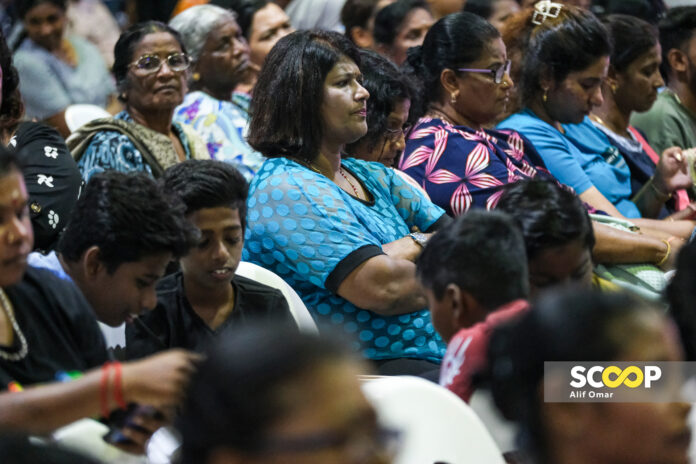
GEORGE TOWN — Faced with a possible loss of Indian support, Pakatan Harapan (PH) should detail its plans to improve the socioeconomic standing of the community, a grassroots leader from the coalition said.
R. Ganeson, the chairman of the Air Itam-based Happy Valley DAP division, said this national-level Indian community development blueprint could answer the grouses many Indian supporters have over inflation and economic woes.
He acknowledged the transfer of PH support among Indians to Perikatan Nasional (PN) in recent elections and urged the ruling coalition to create and present the blueprint in the next three years before the 16th general election (GE16).
“They have to do it at a fast pace before the (next) election.
“This is because whenever an election comes, blueprints get introduced. (Yet) they are unheard of (after elections),” he told Scoop.
The suggestion for PH to have its own development blueprint for the Indian community harks back to the strategy adopted by former prime minister Datuk Seri Najib Razak, whose Barisan Nasional government came up with a ten-year action plan focused on the community.
Najib’s Indian development blueprint included a RM500 million Permodalan Nasional Bhd shares scheme for B40 Indians, increased admissions into higher education institutions, funds and collaboration with an education foundation to tackle academic issues among the community’s children, raising Indian participation in the civil service, and a citizenship plan for stateless Indians born in Malaysia before 1957.

PH has been able to rely on the Indian vote, especially in Penang, since 2008 when the coalition first came to power in the state.
However, there are signs that this support is waning, as seen in the low turnout of Indian voters in the 2023 state elections and the Sg Bakap by-election in July last year.
A 2023 post-state election study by analyst Bridget Welsh, as reported by FMT, found that Indian votes for PH had dropped by 21%, 19%, and 12% in Negeri Sembilan, Penang, and Selangor, respectively. In contrast, Indian votes for PN increased by 29%, 19%, and 14% in those states.
Why Penang Indians are unhappy with PH
Ganeson said the Penang voters who switched from PH to PN did so as a sign of protest against PH.
“They don’t want to vote for PN, but there is no third force (for them to vote for). It is either PH or PN. Therefore, (they voted PN). But it was meant to be temporary, to teach PH a lesson,” he added.
Ganeson and another DAP grassroots leader, who requested anonymity, told Scoop that Indian voters are disappointed with rising inflation, as well as the lack of increment in allocation for the Malaysian Indian Transformation Unit (Mitra) and other federal programmes for the community.
“They would ask for more allocations under the national budgets but when they get a meagre amount in return, they would ask what is the point of voting for PH.
“They are even saying that they would not come out to vote for PH in the 16th general election,” said the unnamed party insider.
Additionally, Ganeson also said the voters are also unhappy with Prime Minister Datuk Seri Anwar Ibrahim whose government is seen as responsible for allowing the graft cases of Umno leaders like Datuk Seri Ahmad Zahid Hamidi off the hook.
A matter of communication
PKR’s A. Kumaresan, however, feels Indian voters would be more understanding if the government practiced better communication with the grassroots.
The Batu Uban assemblyman said those who have complained to him about the Madani government not doing much for the community don’t have enough information and are in the dark about welfare initiatives.
Kumaresan, who is also Penang PKR vice-chairman, refuted popular “myths” among Penang Indians that only RM100 million was allocated for the community through Mitra in Budget 2025, when in fact, more than that has been allocated to the community through various entrepreneurship grants.
That said, Kumaresan also expressed concerns that such funds are often underutilised.
“Some quarters in the opposition are saying that (Mitra) must be given RM200 million or more (in allocations). But, if the community never (fully) utilises the fund, how can we get more (allocations)?
“We should utilise whatever fund that we have. Then only we can ask for more,” he added.
Asked how PH should prevent a larger PH-to-PN voting shift among the community, Kumaresan called upon PH leaders to utilise social media platforms like TikTok to the maximum to disseminate information to voters.
He said the coalition is “a little weak” on its social media strategy.

Additionally, PH leaders should have more face-to-face engagements with the community to inform people of federal and state programmes.
“All assemblymen, MPs and city councillors must play this role. We should not solely depend on the prime minister (to explain the programmes). We need to work as a team,” he said.
Roadshows by leaders should also target low-income areas, and feature booths set up by government agencies to provide services and information for these under-served communities.
Kumaresan’s suggestion to organise more roadshows in needy areas is backed by the unnamed DAP insider who said that these programmes work better for low-income Indians who are not inclined to using social media or the internet to learn about government initiatives.
As other remedies to tackle the flow of Indian support to PN, the party insider also called on the government to do more to tackle the cost of living and provide more education assistance to top scorers from poor Indian families, such as university placements. – January 8, 2025



